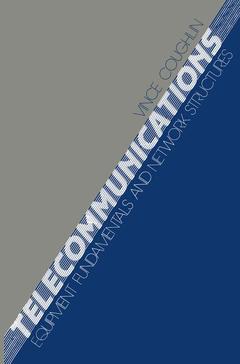Description
Telecommunications, Softcover reprint of the original 1st ed. 1984
Equipment Fundamentals and Network Structures
Author: Coughlin Vincent J.
Language: English
Keywords
Ethernet; LAN; Multiplexer; Standards; communication; information; network design; satellite; telecommunications; transparency
Approximative price 52.74 €
In Print (Delivery period: 15 days).
Add to cart
Publication date: 03-2012
132 p. · 15.2x22.9 cm · Paperback
132 p. · 15.2x22.9 cm · Paperback
Description
/li>Contents
/li>
Modern technology began in the 1950's and 1960's, with the devel opment of transistor technology. At first it was useful in improving the performance of voice communications. But then it made possible extraordinary computer capability in manageable size-and at man ageable cost. First came large mainframe computers for only the largest companies; and later the microcomputer as we know it today. The increasing use of computers, in the 1960's with their ability to manipulate and store vast quantities of information, stimulated the need for computers to communicate with one another and so tele phone circuits had to be segregated and conditioned specifically for computer traffic, using the modem. Computers ushered in a new era of business communications in which data could be developed, ma nipulated, stored or transmitted with remarkable ease. The recent pace of technological advancement has been breath taking and, today, the distinction between communications and computers is no longer even necessary. Computers, at the very core of communications networks, route and control communications on major common carriers. The decade of the 1980's is bearing the fruits of the marriage of computers and communications. For the first time networks are en abling organizations to utilize the combined processing power of computers and communications equipment.
1. The Medium and the Market — An Overview.- 1.1 A Telecommunications Overview.- 1.1.1 Smart Telecom Banking Card Systems.- 1.2 Understanding the Basics.- 1.2.1 Parallel and Serial Transmission.- 1.2.2 Channels and Facilities.- 1.2.3 Digital Versus Analog Transmission.- 1.2.4 Asynchronous and Synchronous Transmission.- 1.3 A Bright Future with Fiber Optics.- 1.3.1 Fiber Selection.- 1.3.2 Light Source Emitters and Detectors.- 1.4 A View from the Business Side.- 1.4.1 How to Set your Requirements.- 1.4.2 Minimizing Line Costs.- 2. Modems and Multiplexers.- 2.1 Introduction.- 2.2 The Role of Modems.- 2.3 Modem Applications.- 2.4 Industry Standards.- 2.5 Modem Features.- 2.6 Multiplexing Reduces Communications Cost.- 2.7 Multiplexer Technology.- 2.8 Statistical Multiplexer.- 2.8.1 Bandsplitter.- 3. Protocols and Codes.- 3.1 What is a Protocol?.- 3.2 Protocol Hierarchy.- 3.3 Physical Electrical Interface.- 3.3.1 Handshaking.- 3.4 Link Control Structure.- 3.4.1 Data Transparency.- 3.4.2 Connection and Disconnection.- 3.4.3 Failure and Recovery.- 3.4.4 Error Control.- 3.4.5 Sequencing.- 3.5 Bisync Protocol.- 3.6 HDLC Protocol.- 3.7 SDLC Overview.- 3.8 System Network Architecture (SNA).- 3.9 Polling Explained.- 3.10 Transmission Codes.- 3.11 Code and Speed Converters.- 3.12 Treatment of Errors.- 3.12.1 Redundancy Checks.- 3.12.2 Error-Correcting Codes.- 3.12.3 Loop Check.- 3.12.4 Effect of Errors.- 3.13 Front-End Processors.- 3.13.1 Selection and Evaluation.- 4. Terminal Technology.- 4.1 CRT Display Terminals.- 4.1.1 Control Unit.- 4.1.2 Keyboard Structure.- 4.1.3 Display Schemes.- 4.1.4 Terminal Considerations.- 4.2 Printing Technologies.- 4.3 Graphic Terminals.- 4.4 Facsimile Technology.- 4.4.1 Stored Switching System.- 4.4.2 Image Resolution.- 4.5 Integrated Workstations.- 5. Network Management.- 5.1 Network Control Design Considerations.- 5.2 Elementary Monitoring.- 5.3 Redundancy and Compatability.- 5.4 Network Testing.- 5.5 Centralized Troubleshooting.- 5.6 Network Control Center.- 5.6.1 Alarms.- 5.6.2 Automatic Trunk Testing.- 5.6.3 Maintenance and Management Reports.- 5.7 Specialized Test Equipment.- 5.7.1 Line Analyzers.- 5.7.2 Breakout Boxes.- 5.7.3 Error Rate Testers.- 5.7.4 Data Monitors.- 5.8 Network Security.- 6. Network Structures.- 6.1 Topology Tradeoffs.- 6.1.1 Front-End and Back-End Networks.- 6.2 Local Area Networks.- 6.2.1 The Ethernet Way.- 6.2.2 LAN Cable Medium Choices.- 6.3 Distributed Communications.- 6.4 Message Switching Networks.- 6.5 Integrated Voice and Data.- 6.6 Shared Resources.- 6.7 Packet Switching Networks.- 6.7.1 The History of X.25.- 6.7.2 How They Work.- 6.7.3 Packet Switching in Operation.- 6.8 Network Design Considerations.- 7. Satellite and Carrier Services.- 7.1 Satellite Overview.- 7.1.1 Overcoming Attenuation.- 7.1.2 Satellite Communications Structure.- 7.2 Selecting a Transmission Method.- 7.2.1 Private Alternatives.- 7.2.2 Measured Use Services.- 7.3 Facsimile Services.- Glossary of Terms.
© 2024 LAVOISIER S.A.S.
These books may interest you

Mobile Multimedia Communications 158.24 €



